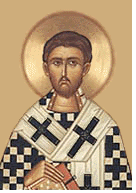...Best of Sicily presents... Best of Sicily Magazine. ... Dedicated to Sicilian art, culture, history, people, places and all things Sicilian. |
by Vincenzo Salerno | |||
Magazine Index Best of Sicily Arts & Culture Fashion Food & Wine History & Society About Us Travel Faqs Contact Map of Sicily
|
The Normans arrived in 1061, reaching Palermo, the capital, by early 1072. The last Arab areas, such as Enna, were not conquered until two decades later. Under the Normans, the Sicilian language became more Latinised, and so did the Church. In Palermo there were twenty Orthodox churches (and hundreds of mosques and dozens of synagogues) when the Normans beseiged and captured the city. They found its bishop, Nicodemus, with his congregation. The old Church of Saint Mary, which had been turned into a mosque some two hundred and forty years earlier, was quickly reconsecrated and Nicodemus celebrated a prayer service there. He was known for his kindness and humility, but the new rulers, after establishing their position, sent him to live outside the city in the area now called Mezzomonreale. The precise reasons are unknown, but it is clear that Roger and Robert de Hauteville wished to install bishops loyal to Rome following the Schism of 1054. In the chronicles of Christianity, the Schism played out at its most dramatic in Sicily, which in the eleventh century was the wealthiest region of Europe and the Mediterranean. By the twelfth century, the tax revenues derived from Palermo alone exceeded those collected by the Norman king of England in his entire realm. Nowhere was ecclesiastical and temporal power contested as in Sicily. Nicodemus, Count Roger, and even the contemporary popes were minor players in this spectacle, whose idealogy transcended human vanity. Bishop of Palermo from 1065, Saint Nicodemus died in 1083. His body is buried in a stone sarcafogous which today can be found in the crypt of the Norman era Palermo Cathedral. About the Author: Palermo native Vincenzo Salerno has written biographies of several famous Sicilians, including Frederick II and Giuseppe di Lampedusa. | ||
Top of Page |
 Amid the recent Catholic devotion to more controversial personages, such as
Padre Pio (whose likeness abounds in southern Italy), many of Sicily's medieval religious figures have been all but
forgotten. One of them is Nicodemus, leader of Sicily's Christians during the last decades of Muslim rule. The early
(Orthodox) church of Sicily was distinctly Byzantine, and indeed part of the Patriarchate of Constantinople. From around
827 until the 1060s, Christians in Sicily, like Jews, became a subjugated people, mildly persecuted and highly taxed but
allowed, in most cases, to practice their religion and professions. There were Orthodox Christian monasteries and
churches, and some Christians were permitted land ownership. Yet, Sicily's population almost doubled during over two
centuries of Saracen (Arab) rule under Muslim law. Clearly, some Christians converted to Islam, and Arabic greatly
influenced the vernacular language of Sicily, which previously had been closer to Greek.
Amid the recent Catholic devotion to more controversial personages, such as
Padre Pio (whose likeness abounds in southern Italy), many of Sicily's medieval religious figures have been all but
forgotten. One of them is Nicodemus, leader of Sicily's Christians during the last decades of Muslim rule. The early
(Orthodox) church of Sicily was distinctly Byzantine, and indeed part of the Patriarchate of Constantinople. From around
827 until the 1060s, Christians in Sicily, like Jews, became a subjugated people, mildly persecuted and highly taxed but
allowed, in most cases, to practice their religion and professions. There were Orthodox Christian monasteries and
churches, and some Christians were permitted land ownership. Yet, Sicily's population almost doubled during over two
centuries of Saracen (Arab) rule under Muslim law. Clearly, some Christians converted to Islam, and Arabic greatly
influenced the vernacular language of Sicily, which previously had been closer to Greek.